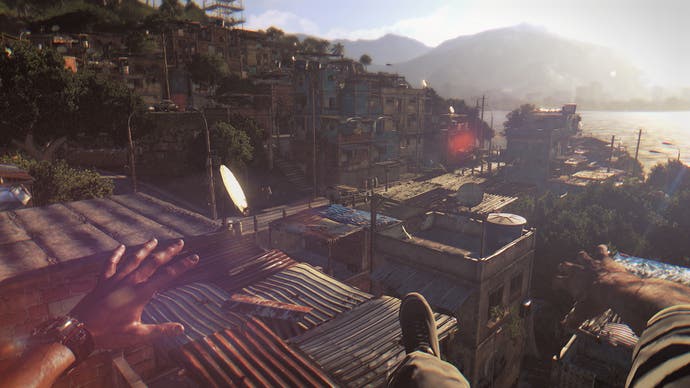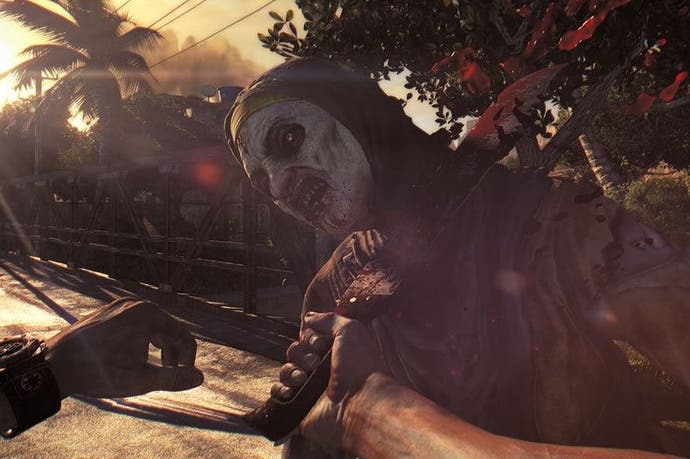How Dying Light is keeping the zombie genre fresh
Techland's third stab at the zombie apocalypse borrows from the best.
Dying Light isn't a cool game to like. On the surface, it reeks of a design-by-committee approach to blockbuster development. It's got zombies. It's got an open world. It's got parkour. And stealth. And an upgrade tree. It even casts you as a generic badass dude with a woman who barks orders at you through a walkie-talkie. Heck, it's developed by Techland, who just did the open-world zombie thing twice, to questionable effect, in its divisive Dead Island series. Dying Light should be a banal wreck: the video game equivalent of the KFC Famous Bowl. That's what makes it all the more surprising that it was one of the hardest games to put down at this year's E3.
The key to Dying Light's success could be its balance. Perhaps its most notable feature is how it changes its gameplay dynamics in tune to the time of day. By day, the zombies are steep in numbers, but their lackadaisical behaviour leaves them a relatively minor threat as you trot across the game's abandoned tropical city. It's like Dead Island starring Mirror's Edge's free-running heroine Faith, or Dead Rising with an emphasis on traversal rather than armaments.
By night, everything changes. Certain zombies became more aggressive and will call attention to you if you fall in their line of sight. Suddenly it becomes a stealth game, and a pretty good one at that, as your fleet-footed manoeuvres give you plenty of options in how to navigate the terrain. Do you want to creep through the bushes, climb over the rooftops or toss decoys to lure the undead away?
Either of these gameplay types might get a little long in the tooth on their own, but based on my half-hour hands-on session with Dying Light, it seems like the pacing is well tuned to make these play styles blend together harmoniously. Better yet, there's a smart interplay between them where you can set traps during the day, then use them when you've got zombies on your tail at night. The traps occupy a fairly wide radius on your mini-map and are set off with context-sensitive prompts, so these become your go-to points when trying to shake a zombie horde in the dead of night.
This is all well and good, but Dying Light will likely get its legs from an immense skill tree that ensures you're constantly growing more powerful. Like Crackdown before it, you earn experience by doing. So if you want to improve your agility you'll want to run, jump and climb. To upgrade your strength you'll want to smack zombies with a variety of weapons.
Upon levelling up my agility for the first time, I'm given the option to choose between a slide-kick and dodge manoeuvre, but as time goes on I'm given new moves like one-hit stealth kills, aerial takedowns or the ability to leap over zombies' shoulders like Tony Jaa. I can also choose to bolster my stats by reducing fall damage or take a buff that refills my health for 15 seconds when it drops below 15 per cent. As you progress in the adventure, you'll also gain new critical abilities like a grappling hook that works as a zipwire, immediately pulling you to any surface within its fairly generous reach, a la Batman: Arkham City or Just Cause 2. According to the developer, this is all stuff you can acquire in the game's first half, so there's plenty more room to grow.

As in any good zombie fiction, the undead are not your biggest threat; the island is littered with other humans. Some of them are friendly and you can barter with them in shelters, but many of your fellow homo sapiens are jerks who won't think twice about killing you. One outpost I come across is full of adversarial soldiers. My attempt to lure zombies to them isn't fruitful by day, but when I try the same strategy at night, it's a success. Thanks, zombies! Of course, this could have easily gone the other way, as getting into a gunfight could lure the undead, so this three-way dynamic between the dumb, sound-sensitive zombies and the armed human foes gives Dying Light a more varied, emergent feel than one might expect.
Dying Light won't win any awards for originality, but this could be the one that gets it right. It merges the most empowering elements of Mirror's Edge, Dead Rising, Just Cause 2 and Batman: Arkham City with the sandbox dynamics and light stealth of Far Cry and Assassin's Creed. Those aren't bad inspirations to crib from. Say what you will about KFC Famous Bowls, but I guess they're the top-selling item for a reason.


